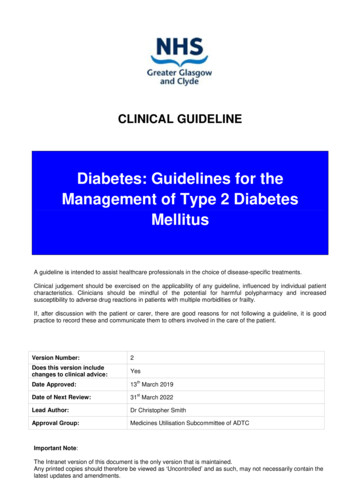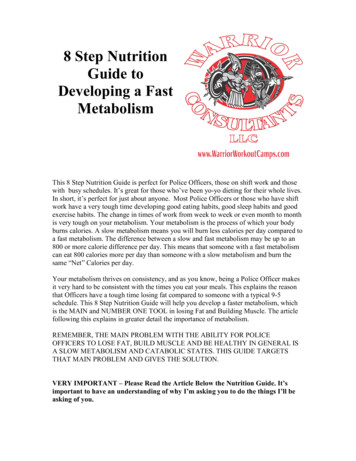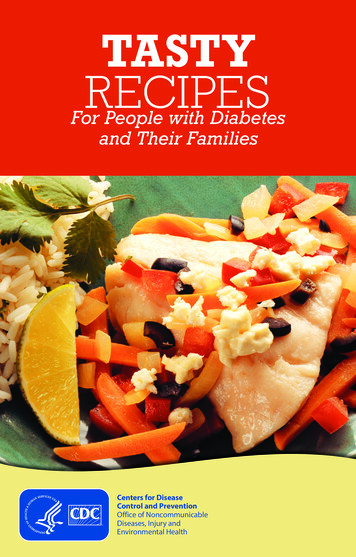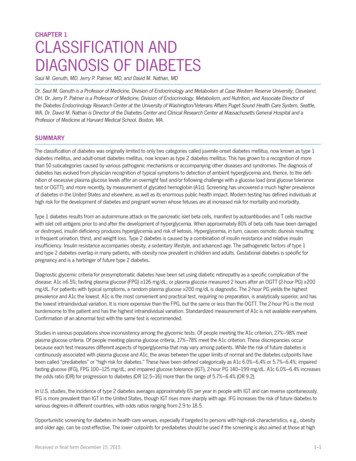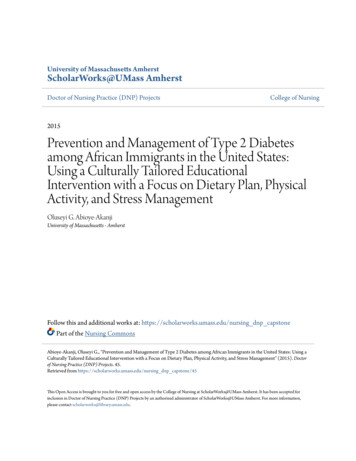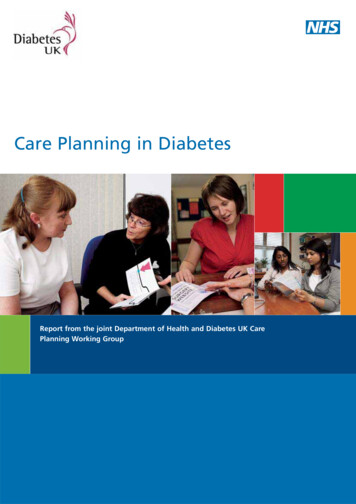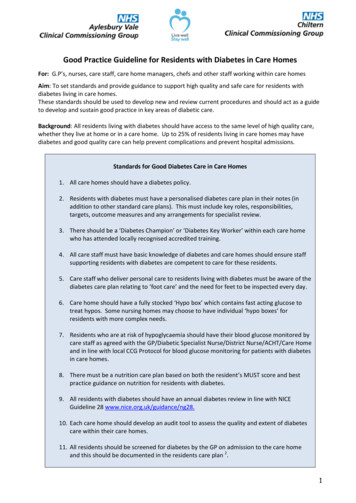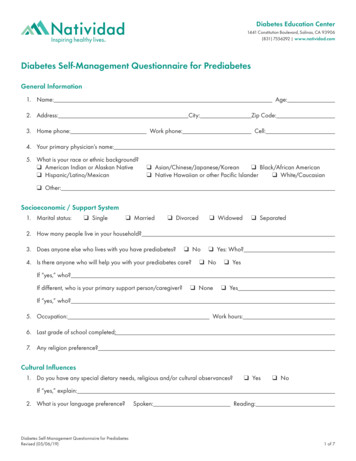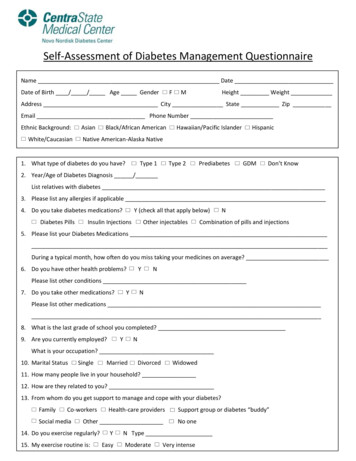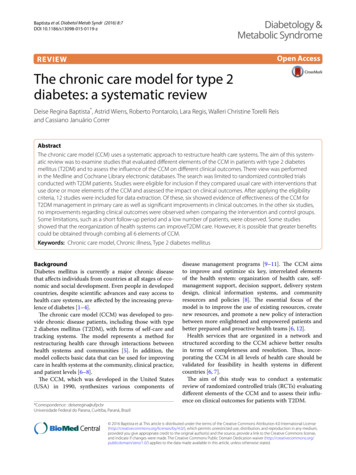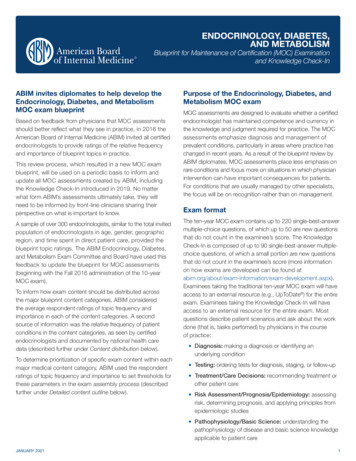
Transcription
ENDOCRINOLOGY, DIABETES,AND METABOLISM Blueprint for Maintenance of Certification (MOC) Examinationand Knowledge Check-InABIM invites diplomates to help develop theEndocrinology, Diabetes, and MetabolismMOC exam blueprintBased on feedback from physicians that MOC assessmentsshould better reflect what they see in practice, in 2016 theAmerican Board of Internal Medicine (ABIM) invited all certifiedendocrinologists to provide ratings of the relative frequencyand importance of blueprint topics in practice.This review process, which resulted in a new MOC examblueprint, will be used on a periodic basis to inform andupdate all MOC assessments created by ABIM, includingthe Knowledge Check-In introduced in 2019. No matterwhat form ABIM’s assessments ultimately take, they willneed to be informed by front-line clinicians sharing theirperspective on what is important to know.A sample of over 300 endocrinologists, similar to the total invitedpopulation of endocrinologists in age, gender, geographicregion, and time spent in direct patient care, provided theblueprint topic ratings. The ABIM Endocrinology, Diabetes,and Metabolism Exam Committee and Board have used thisfeedback to update the blueprint for MOC assessments(beginning with the Fall 2016 administration of the 10-yearMOC exam).To inform how exam content should be distributed acrossthe major blueprint content categories, ABIM consideredthe average respondent ratings of topic frequency andimportance in each of the content categories. A secondsource of information was the relative frequency of patientconditions in the content categories, as seen by certifiedendocrinologists and documented by national health caredata (described further under Content distribution below).To determine prioritization of specific exam content within eachmajor medical content category, ABIM used the respondentratings of topic frequency and importance to set thresholds forthese parameters in the exam assembly process (describedfurther under Detailed content outline below).Purpose of the Endocrinology, Diabetes, andMetabolism MOC examMOC assessments are designed to evaluate whether a certifiedendocrinologist has maintained competence and currency inthe knowledge and judgment required for practice. The MOCassessments emphasize diagnosis and management ofprevalent conditions, particularly in areas where practice haschanged in recent years. As a result of the blueprint review byABIM diplomates, MOC assessments place less emphasis onrare conditions and focus more on situations in which physicianintervention can have important consequences for patients.For conditions that are usually managed by other specialists,the focus will be on recognition rather than on management.Exam formatThe ten-year MOC exam contains up to 220 single-best-answermultiple-choice questions, of which up to 50 are new questionsthat do not count in the examinee’s score. The KnowledgeCheck-In is composed of up to 90 single-best-answer multiplechoice questions, of which a small portion are new questionsthat do not count in the examinee’s score (more informationon how exams are developed can be found .aspx).Examinees taking the traditional ten-year MOC exam will haveaccess to an external resource (e.g., UpToDate ) for the entireexam. Examinees taking the Knowledge Check-In will haveaccess to an external resource for the entire exam. Mostquestions describe patient scenarios and ask about the workdone (that is, tasks perfomed) by physicians in the courseof practice: D iagnosis: making a diagnosis or identifying anunderlying condition Testing: ordering tests for diagnosis, staging, or follow-up T reatment/Care Decisions: recommending treatment orother patient care R isk Assessment/Prognosis/Epidemiology: assessingrisk, determining prognosis, and applying principles fromepidemiologic studies P athophysiology/Basic Science: understanding thepathophysiology of disease and basic science knowledgeapplicable to patient careJANUARY 20211
Clinical scenarios presented take place in outpatient orinpatient settings as appropriate to a typical Endocrinology,Diabetes, and Metabolism practice. Clinical informationpresented may include diagnostic imaging studies,continuous glucose monitoring tracings, radiographicstudies, or patient photographs.Tutorials for the traditional ten-year MOC exam and for theKnowledge Check-In, including examples of ABIM examquestion format, can be found at .aspx.Blueprint reviewers provided ratings of relative frequency inpractice for each of the detailed content topics in the blueprintand provided ratings of the relative importance of the topicsfor each of the tasks described in Exam format above. In ratingimportance, reviewers were asked to consider factors suchas the following: High risk of a significant adverse outcome Cost of care and stewardship of resources Common errors in diagnosis or managementContent distributionListed below are the major medical content categories thatdefine the domain for the Endocrinology, Diabetes, andMetabolism MOC ten-year exam and the Knowledge Check-In.The relative distribution of content is expressed as a percentageof the total exam. To determine the content distribution, ABIMconsidered the average respondent ratings of topic frequencyand importance. To cross-validate these self-reported ratings,ABIM also considered the relative frequency of conditions seenin Medicare patients by a cohort of certified endocrinologists.Informed by these data, the Endocrinology, Diabetes, andMetabolism Board Exam Committee and Board determinedthe content category targets shown below.CONTENT CATEGORYHow the blueprint ratings are used to assemblethe MOC examTARGET %Adrenal Disorders9%Pituitary Disorders9%Lipids, Obesity, and Nutrition14%Female Reproduction6%Male Reproduction6%Diabetes Mellitus and Hypoglycemia26%Calcium and Bone Disorders15%Thyroid Disorders15%Total100% Effect on population health Effect on quality of life When failure to intervene by the physician deprivesa patient of significant benefitFrequency and importance were rated on a three-point scalecorresponding to low, medium, or high. The median importanceratings are reflected in the Detailed content outline below.The Endocrinology, Diabetes, and Metabolism Board ExamCommittee and Board, in partnership with the physiciancommunity, have set the following parameters for selectingMOC exam questions according to the blueprint review ratings: At least 75% of exam questions will addresshigh-importance content (indicated in green) No more than 25% of exam questions will addressmedium-importance content (indicated in yellow) No exam questions will address low-importance content(indicated in red)Independent of the importance and task ratings, no more than25% of exam questions will address low-frequency content(indicated by “LF” following the topic description).The Endocrinology, Diabetes, and Metabolism MOC exam maycover other dimensions of medicine as applicable to the medicalcontent categories, such as adolescent medicine.JANUARY 20212
The content selection priorities below are applicable beginning with the Fall 2016 MOC exam and are subjectto change in response to future blueprint review.Note: The same topic may appear in more than one medical content category.Detailed content outline for the Endocrinology, Diabetes, and Metabolism MOC exam andKnowledge Check-In– High Importance: At least 75% of examquestions will address topics and taskswith this designation.– Medium Importance: No more than 25%of exam questions will address topics andtasks with this designation.– Low Importance: No exam questionswill address topics and tasks withthis designation.LF – Low Frequency: No more than 25% of exam questions will address topics with this designation, regardless of task or importance.ADRENAL DISORDERS(9% of exam)DiagnosisTestingTreatment/Care DecisionsRisk asic ScienceGLUCOCORTICOIDS (3.5% of exam)Cushing syndromeManagement of glucocorticoidtherapyNot ApplicableAdrenal insufficiencyGlucocorticoid resistanceLFMINERALOCORTICOIDS (2% of exam)HyperaldosteronismHypoaldosteronismLFADRENAL ANDROGENS ( 2% of exam)Congenital adrenal hyperplasiaLFADRENAL INCIDENTALOMA ( 2% of exam)Adrenal incidentalomaADRENAL MEDULLA ( 2% of exam)Pheochromocytoma andparagangliomaLFNeurofibromatosis type 1LFvon Hippel Lindau syndromeLFMultiple endocrine neoplasia (MEN)types 2A and 2BLFFamilial paraganglioma syndromesLFFamilial paragangliomapheochomocytoma syndromesLFJANUARY 2021*This topic was added or revised after the blueprint was reviewed by Endocrinology diplomates; it has beenprovisionally rated by the Endocrinology Exam Committee, pending the next blueprint review process.3
– High Importance: At least 75% of examquestions will address topics and taskswith this designation.– Medium Importance: No more than 25%of exam questions will address topics andtasks with this designation.– Low Importance: No exam questionswill address topics and tasks withthis designation.LF – Low Frequency: No more than 25% of exam questions will address topics with this designation, regardless of task or importance.ADRENAL DISORDERSTestingTreatment/Care DecisionsRisk asic ScienceTestingTreatment/Care DecisionsRisk asic Sciencecontinued (9% of exam)DiagnosisADRENAL CANCER ( 2% of exam)Adrenal cancerLFPITUITARY DISORDERS(9% of exam)DiagnosisPROLACTIN ( 2% of exam)HyperprolactinemiaNormoprolactinemic galactorrheaGROWTH HORMONE ( 2% of exam)AcromegalyLFDeficiencyLFTHYROID-STIMULATING HORMONE (TSH) ( 2% of exam)TSH-secretingLFHyperplasia secondary tolongstanding primaryhypothyroidismLFTSH deficiencyLFGONADOTROPINS ( 2% of exam)Gonadotroph pituitary tumorsLFHypogonadotropic hypogonadismNONSECRETING PITUITARY TUMORS ( 2% of exam)Nonsecreting pituitary tumorsADRENOCORTICOTROPIC HORMONE (ACTH) ( 2% of exam)Cushing diseaseLFACTH deficiencyLFJANUARY 2021*This topic was added or revised after the blueprint was reviewed by Endocrinology diplomates; it has beenprovisionally rated by the Endocrinology Exam Committee, pending the next blueprint review process.4
– High Importance: At least 75% of examquestions will address topics and taskswith this designation.– Medium Importance: No more than 25%of exam questions will address topics andtasks with this designation.– Low Importance: No exam questionswill address topics and tasks withthis designation.LF – Low Frequency: No more than 25% of exam questions will address topics with this designation, regardless of task or importance.PITUITARY DISORDERScontinued (9% of exam)DiagnosisTestingTreatment/Care DecisionsRisk asic ScienceHYPOPITUITARISM ( 2% of exam)Clinical presentationCausesTumorsPituitary apoplexyLFSheehan syndromeLFHemochromatosisLFLymphocytic hypophysitisLFSarcoidosisLFTraumatic brain injuryLFIatrogenic (radiation, surgery)TreatmentAdjustment of growth hormoneaccording to insulin-like growthfactor-1 (IGF-1) levelsLFNot ApplicableMonitoring of thyroid with freethyroxine (T4)Not ApplicableClinical adjustment ofglucocorticoidsNot ApplicableEMPTY SELLA SYNDROME ( 2% of exam)Empty sella syndromeANTIDIURETIC HORMONE (ADH) ( 2% of exam)Diabetes insipidusLFSyndrome of inappropriateantidiuretic hormone secretion(SIADH)CRANIOPHARYNGIOMA ( 2% of exam)CraniopharyngiomaLFPITUITARY INCIDENTALOMA ( 2% of exam)Pituitary incidentalomaJANUARY 2021*This topic was added or revised after the blueprint was reviewed by Endocrinology diplomates; it has beenprovisionally rated by the Endocrinology Exam Committee, pending the next blueprint review process.5
– High Importance: At least 75% of examquestions will address topics and taskswith this designation.– Medium Importance: No more than 25%of exam questions will address topics andtasks with this designation.– Low Importance: No exam questionswill address topics and tasks withthis designation.LF – Low Frequency: No more than 25% of exam questions will address topics with this designation, regardless of task or importance.LIPIDS, OBESITY, AND NUTRITION(14% of exam)DiagnosisTestingTreatment/Care DecisionsRisk asic ScienceHYPERCHOLESTEROLEMIA ( 2% of exam)Primary disordersFamilial hypercholesterolemiaFamilial defective apolipoproteinB-100LFLipoprotein (a)LFElevated high-density lipoproteincholesterolLFSecondary disordersHYPERTRIGLYCERIDEMIA (2% of exam)Primary disordersFamilial hypertriglyceridemiaApoprotein/lipase disordersLFSecondary disordersChylomicronemia syndromeLFELEVATED TRIGLYCERIDES AND LOW-DENSITY LIPOPROTEIN CHOLESTEROL (3% of exam)Primary disordersFamilial combined hyperlipidemiaFamilial dysbetalipoproteinemia(type III)LFHypobetalipoproteinemia(Low LDL-c)LF*****Secondary disordersHYPOLIPIDEMIA (0% of exam)Primary disordersLFSecondary disordersLFJANUARY 2021*This topic was added or revised after the blueprint was reviewed by Endocrinology diplomates; it has beenprovisionally rated by the Endocrinology Exam Committee, pending the next blueprint review process.6
– Medium Importance: No more than 25%of exam questions will address topics andtasks with this designation.– High Importance: At least 75% of examquestions will address topics and taskswith this designation.– Low Importance: No exam questionswill address topics and tasks withthis designation.LF – Low Frequency: No more than 25% of exam questions will address topics with this designation, regardless of task or importance.LIPIDS, OBESITY, AND NUTRITIONcontinued (14% of exam)DiagnosisTestingTreatment/Care DecisionsRisk asic ScienceTREATMENT OF LIPID DISORDERS (5% of exam)DietNot Ap
The Endocrinology, Diabetes, and Metabolism Board Exam Committee and Board, in partnership with the physician community, have set the following parameters for selecting MOC exam questions according to the blueprint review ratings: At least 75% of exam questions will address high-importance content (indicated in green)
